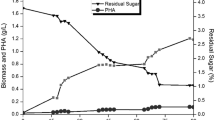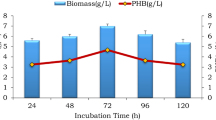Abstract
In this study, 50 bacterial strains were screened for polyhydroxyalkanoate (PHA) production. The isolated bacterial strain Bacillus flexus ME-77 was found to be the most potent PHA producer. The extracted PHA was analyzed using NMR techniques, which showed that it is of the polyhydroxybutyrate (PHB) type. The highest PHB production (4.5 g/L) was achieved using 30 g/L sugarcane molasses (SCM) at pH 7.5 and applying 1, 0.2 and 0.03 g/L of phosphate, MgSO4 7H2O and CaCl2, respectively, at 27 °C incubation temperature and 200 rpm agitation speed. The bacterial strain Bacillus flexus ME-77 with its potential could be further explored for cost-effective production of PHAs using low-cost agro-industrial food wastes such as sugarcane molasses as a low-cost sole carbon source.














Similar content being viewed by others
References
Akar A, Akkaya E, Yesiladali S et al (2006) Accumulation of polyhydroxyalkanoates by Microlunatus phosphovorus under various growth conditions. J Ind Microbiol Biotechnol 33:215–220
Akaraonye E, Keshavarz T, Roy I (2010) Production of polyhydroxyalkanoates: the future green materials of choice. J ChemTechnol Biotechnol 85:732–743
Anderson A, Dawes E (1990) Occurence, metabolic role and industrial uses of bacterial polyhydroxyalkanolates. Microbiol Rev 54:450–472
Atlas R (1993) Microbial ecology: fundamentals and applications, third ed., pp. 39–43. Appl Environ Microbiol 54:2924–2932
Ausubel F, Brent R, Kingston R et al (eds) (1999) Short protocols in molecular biology. Willey, NY
Benoit T, Wilson G, Baygh C (1990) Fermentation during growth and sporulation of Bacillus thuringiensis HD-1. J Appl Microbiol 10:15–18
Berlanga M, Montero M, Fernandez-Borrell J, Guerrero R (2006) Rapid spectrofluorometric screening of poly-hydroxyalkanoate-producing bacteria from microbial mats. Int Microbiol 9:95–102
Borah B, Thakur P, Nigam J (2002) The influence of nutritional and environmental conditions on the accumulation of poly-hydroxybutyrate in Bacillus mycoides RLJ B-017. J Appl Microbiol 92:776–783
Degelau A, Scheper T, Bailey J, Guske C (1995) Fluorometric measurement of poly-β-hydroxybutyrate in Alcaligenes eutrophus by flow cytometry and spectrofluorometry. Appl Environ Microbiol 42:653–657
Divyashree M, Shamala T, Rastogi N (2009a) Isolation of polyhydroxyalkanoate from hydrolyzed cells of Bacillus flexus using aqueous two-phase system containing polyethylene glycol and phosphate. Biotechnol Bioprocess Eng 14:482–489
Divyashree M, Navin K, Shamala T (2009b) A simple kinetic model for growth and biosynthesis of polyhydroxyalkanoate in Bacillus flexus. New Biotechnol 26:92–98
Findlay R, White D (1983) Polymeric beta-hydroxyalkanoates from environmental samples and Bacillus megaterium. Appl Environ Microbiol 45:71–78
Freeman M, Baehler C, Spotts S (1990) Automated lazer fluorescence sequencing. Biotechnology 8:147–148
Gorenflo V, Steinbüchel A, Marose S et al (1999) Quantification of bacterial polyhydroxy-alkanoic acids by Nile red staining. Appl Microbiol Biotechnol 51:765–772
Gouda M, Swellam A, Omar S (2001) Production of PHB by a Bacillus megaterium strain using sugarcane molasses and corn steep liquor as sole carbon and nitrogen source. Microbiol Res 156:201–207
Ha C, Cho W (2002) Miscibility, properties, and biodegradability of microbial polyester containing blends. Prog Polym Sci 27:759–809
Halami P (2007) Production of polyhydroxyalkanoate from starch by the native isolate Bacillus cereus CFR06. World J Microbiol Biotechnol 24:805–812
Hall T (1999) BioEdit: a user-friendly biological sequence alignment and analysis program for Windows 95/98/NT. Nucleic Acids Symp Ser 41:95–98
Huang SJ (2002) An Overview of Biodegradable Polymers and Biodegradation of Polymers. In: Scott G (ed) Degradable polymers, principles and applications. Springer, Berlin, pp 17–26
Johnstone B (1990) A throw away answer. Far East Econ Rev 147:62–63
Kadouri D, Jurkevitch E, Okon Y, Castro-Sowinski S (2005) Ecological and agricultural significance of bacterial polyhydroxy-alkanoates. Crit Rev Microbiol 31:55–67
Kim Y, Lenz R (2001) Polyesters from microorganisms. Adv Biochem Eng Biotechnol 71:51–79
Klüttermann K, Tauchert H, Kleber H (2002) Synthesis of poly-β-hydroxybutyrate by Agrobacterium radiobacter after growth on d-Carnitine. Acta Biotechnol 22:261–269
Kragelund C, Nielsen J, Thomsen T, Nielsen P (2005) Ecophysiology of the filamentous Alphaproteobacterium Meganema perideroedes in activated sludge. FEMS Microbiol Ecol 54:111–122
Kreig N, Holt J (1984) Bergey’s manual of systematic Bacteriology. Williams & Wilkins, Baltimore
Madison L, Huisman G (1999) Metabolic engineering of poly (3-hydroxyalkanoates): from DNA to plastic. Microbiol Mol Biol Rev 63:21–53
Manna A, Banerjee R, Paul A (1999) Accumulation of poly (3-hydroxybutyric acid) by some soil Streptomyces. Curr Microbiol 39:153–158
Nam D, Ryu D (1985) Relationship between butirosin biosynthesis and sporulation in Bacillus circulans. Antimicrob Agents Chemother 27:789–801
Narayan R (1993) Biodegradable plastics. In: Opportunities for innovation in biotechnology—National Institute of Standards and Technology (NIST, U.S. Department of Commerce) Monograph, NIST GCR–93–633, p 135
Oderinde R, Ngoka L, Adesogan K (1986) Comparative study of the effect of ferrocyanide and EDTA on the production of ethyl alcohol from molasses by Saccharomyces cerevisiae. Biotechnol Bioeng 28:1156–1162
Oliveira F, Freire D, Castilho L (2004) Production of poly (3-hydroxybutyrate) by solid-state fermentation with Ralstonia eutropha. Biotechnol Lett 26:1851–1855
Page RT (1996) Review: an application to display phylogenetic trees on personal computers. Comput Appl Biosci 12:357–358
Pal A, Prabhu A, Kumar A et al (2009) Optimization of process parameters for maximum poly-β-hydroxybutyrate (PHB) production by Bacillus thuringiensis IAM 12077. Polish J Microbiol 58:149–154
Pankajakshan D, Agrawal D (2010) Scaffolds in tissue engineering of blood vessels. Can J Physiol Pharmacol 88:855–873
Pfennig N (1974) Rhodopseudomonas globiformis sp. n., a new species of the Rhodospirillaceae. Arch Microbiol 100:197–206
Priest FG, Goodfellow M, Todd C (1988) A numerical classification of the genus Bacillus. J Gen Microbiol 134:1847–1882
Prober J, Trainor G, Dam R, Hobbs F, Robertson C, Zagursky R, Cocuzza A, Jensen M, Baumeister K (1987) A system for rapid DNA sequencing with fluorescent chain-terminating dideoxynucleotides. Science 238:336–341
Reddy C, Ghai R, Rashmi, Kalia V (2003) Polyhydroxyalkanoates: an overview. Biores Technol 87:137–146
Sambrook J, Fritsch E, Maniatis T (1989) Molecular cloning laboratory manual. Cold Spring Harbor Laboratory, NY
Sanger F, Nicklen S, Coulson A (1977) DNA sequencing with chain terminating inhibitors. Proc Nat Acad Sci USA 74:5463–5467
Sivaprakasam S, Mahadevan S, Sekar S, Rajakumar S (2008) Biological treatment of tannery wastewater by using salt-tolerant bacterial strains. Microb Cell Fact 7:15
Slepecky R, Law J (1960) A rapid spectrophotometric assay for alpha, beta-unsaturated acids and beta-hydroxy acids. Anal Chem 32:1697–1699
Spiekermann P, Rehm B, Kalscheuer R et al (1999) A sensitive, viable-colony staining method using Nile red for direct screening of bacteria that accumulate polyhydroxyalkanoic acids and other lipid storage compounds. Arch Microbiol 71:73–80
Steinbüchel A (1991) Polyhydroxyalkanoaic acids. In: Byrom D (ed) Biomaterials: novel materials from biological sources. Stockton Press, New York, pp 123–213
Sudesh K, Lwata T (2008) Sustainability of biobased and biodegradable plastics. Clean J 36:433–442
Sudesh K, Abe H, Doi Y (2000) Synthesis, structure and properties of polyhydroxyalkanoates: biological polyesters. Prog Polymer Sci 25:1503–1555
Teclu D, Tivchev G, Laing M, Wallis M (2008) Determination of the elemental composition of molasses and its suitability as carbon source for growth of sulphate-reducing bacteria. J Hazard Mater 161:1157–1165
Tokiwa Y, Calabia B (2007) Biodegradability and biodegradation of polyesters. J Polym Environ 15:259–267
Valappil S, Misra S, Boccaccini A et al (2007) Large-scale production and efficient recovery of PHB with desirable material properties, from the newly characterized Bacillus cereus SPV. J Biotechnol 132:251–258
Vijayendra S, Rastogi N, Kumar P et al (2007) Optimization of polyhydroxybutyrate production by Bacillus sp. CFR 256 with corn steep liquor as a nitrogen source. Ind J Microbiol 47:170–175
Witholt B, Kessler B (2002) Perspectives of medium-chain-length poly (hydroxy-alkanoates), a versatile set of bacterial bioplastics. Curr Opin Biotechnol 10:279–285
Zagar J (2000) The end of cheap conventional oil. The Proceedings of Energy Efficiency Policy Symposium. http://www.hawaii.gov/dbedt/ent/symposium/zagar.pdf
Zhang S, Norrlo O, Wawrzynczyk J, Dey E (2004) Poly (3 hydroxybutyrate) biosynthesis in the biofilm of Alcaligenes eutrophus, using glucose enzymatically released from pulp fiber sludge. Appl Environ Microbiol 70:6776–6782
Author information
Authors and Affiliations
Corresponding author
Rights and permissions
About this article
Cite this article
El-Sheekh, M.M., El-Abd, M.A., El-Diwany, A.I. et al. Poly-3-hydroxybutyrate (PHB) production by Bacillus flexus ME-77 using some industrial wastes. Rend. Fis. Acc. Lincei 26, 109–119 (2015). https://doi.org/10.1007/s12210-014-0368-z
Received:
Accepted:
Published:
Issue Date:
DOI: https://doi.org/10.1007/s12210-014-0368-z




